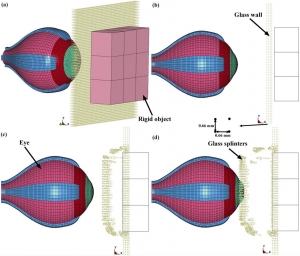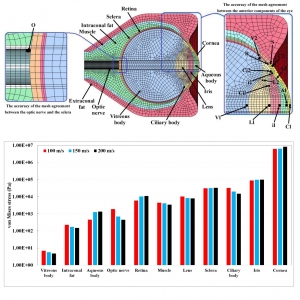

Collision of the glass shards with the eye: A computational fluid-structure interaction model
- Dynamic FSI study was performed to compute injury to the eye because of glass splinters.
- The smoothed particle hydrodynamics glass splinters were shoot to the eye.
- The highest and lowest amount of stresses were observed in the cornea and vitreous body.
- Increasing the speed of glass splinters amplifies the injury in the anterior side of the eye.
- The optic nerve experienced an insignificant injury after the impact.
The main stream of blunt trauma injuries has been reported to be related to the automobile crashes, sporting activities, and military operations. Glass shards, which can be induced due to car accident, earthquake, gunshot, etc., might collide with the eye and trigger substantial scarring and, consequently, permanently affect the vision. The complications as a result of the collision with the eye and its following injuries on each component of the eye are difficult to be diagnosed. The objective of this study was to employ a Three-Dimensional (3D) computational Fluid-Structure Interaction (FSI) model of the human eye to assess the results of the glass shards collision with the eye. To do this, a rigid steel-based object hit a Smoothed-Particle Hydrodynamics (SPH) glass wall at the velocities of 100, 150, and 200 m/s and, subsequently, the resultant glass shards moved toward the eye. The amount of injury, then, quantified in terms of the stresses and strains. The results revealed the highest amount of stress in the cornea while the lowest one was observed in the vitreous body. It was also found that increasing the speed of the glass shards amplifies the amount of the stress in the components which are located in the central anterior zone of the eye, such as the cornea, aqueous body, and iris. However, regarding those components located in the peripheral/posterior side of the eye, especially the optic nerve, by increasing the amount of velocity a reduction in the stresses was observed and the optic nerve is hardly damaged. These findings have associations not only for understanding the amount of stresses/strains in the eye components at three different velocities, but also for providing preliminary information for the ophthalmologists to have a better diagnosis after glass shards (small objects impact) injuries to the eye.
Our services
Consulting and conducting industrial and academic projects related to mechanical engineering, civil engineering, biomedical engineering, mining engineering, etc. based on Finite Element Modeling (FEM)
Contact
Just feel free and let us know if you have any questions and we are looking forward to hearing from you guys.
Email: info@rezarazaghi.com
WhatsApp: +989397091737


